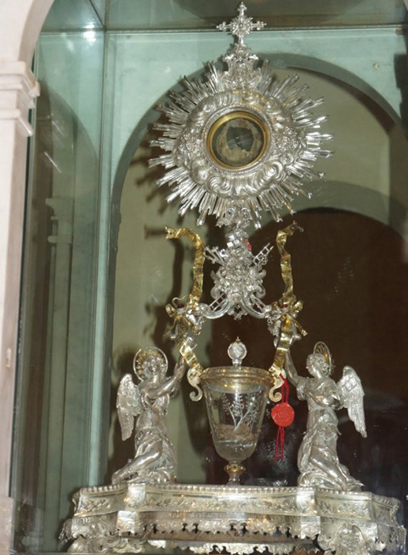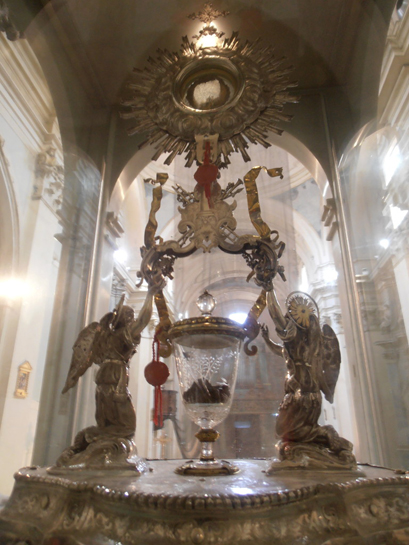

Eucharistic Miracle of Lanciano, Italy
 |
 |
Above in monstrance the miraculous host became Flesh; below in Chalace, the wine that became Blood.
In the 8th century, a priest in Lanciano, Italy was experiencing doubts about the real presence of Jesus in the Eucharist. In the middle of saying Mass, he said the words of consecration (“This is my body,” “This is my blood) and saw the bread and wine transform into real human flesh and blood. The blood coagulated into five globules (later believed to be representative of the five wounds of Christ). Word of the miracle quickly spread, the local archbishop launched an investigation, and the Church approved the miracle. The flesh is still preserved to this day. Professor of anatomy Odoardo Linoli conducted a scientific analysis of the flesh in 1971 and concluded that the flesh was cardiac tissue, the blood appeared to be fresh blood (as opposed to blood that was 1200 years old), and there was no trace of preservatives.
Here are the basic results: 1. The “miraculous Flesh" is authentic flesh consisting of muscular striated tissue of the myocardium (heart wall). Having no trace whatsoever of any agents used for preservation. 2. The “miraculous Blood" is truly blood. The chromatographic analysis indicated this with absolute and indisputable certainty. 3. The immunological study shows with certitude that the flesh and the blood are human, and the immuno hematological test allows us to affirm with complete objectivity and certitude that both belong to the same blood type AB – the same blood type as that of the man of the Shroud and the type most characteristic of Middle Eastern populations. 4. The proteins contained in the blood have the normal distribution, in the identical percentage as that of the serous-proteic chart for normal fresh blood. 5. No histological dissection has revealed any trace of salt infiltrations or preservative substances used in antiquity for the purpose of embalming. Professor Linoli also discarded the hypothesis of a hoax carried out in past centuries. This report was published in The Sclavo Notebooks in Diagnostics (Collection #3, 1971) and a roused great interest in the scientific world. Also, in 1973, the chief Advisory Board of the World Health Organization appointed a scientific commission to corroborate Linoli’s findings. Their work lasted 15 months and included 500 tests. It was verified that the fragments taken from Lanciano could in no way be likened to embalmed tissue. As to the nature of the fragment of flesh, the commission declared it to be living tissue because it responded rapidly to all the clinical reactions distinctive of living beings. Their reply fully corroborated Professor Linoli’s conclusions. In the extract summarizing the scientific work of the Medical Commission of the WHO and the UN, published in Dec. 1976 in New York and Geneva, declared that science, aware of its limits, has come to a halt, face to face with the impossibility of giving an explanation. You can [visit] the miraculous flesh and blood in the Church of San Francesco in Lanciano, Italy. Learn more about these events [pt1], [pt2], [here], and [here].
|